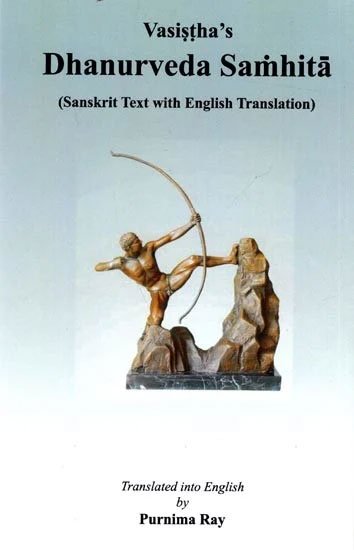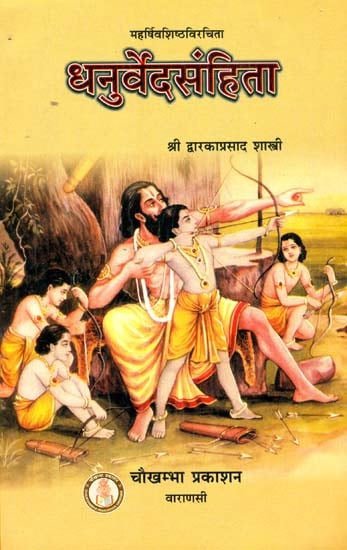Dhanurveda Samhita [sanskrit]
3,015 words
The Sanskrit text of the Dhanurveda-samhita attributed to Vasishtha. Dhanur Veda is a type of ancient India science whose roots date to the 2nd millenium BCE. It is counted among the Upavedas literature. This specific version of the Dhanurveda contains roughly 240 sections of Sanskrit text.
Verse 2.38
अतो वै कातरं राजा बलेनैव नियोजयेत् ।
द्वाविमौ पुरुषो लोके सूर्य्यमण्डलभेदिनौ ॥ ३८ ॥
ato vai kātaraṃ rājā balenaiva niyojayet |
dvāvimau puruṣo loke sūryyamaṇḍalabhedinau || 38 ||
Note! The following is not a translation of the above verse, but merely an arbitrary extract of the English text.
That is why the king should forcefully employ the coward. The two solar systems in this world are different from the sun’s orbit.
English translation by Hardayalu Swami (2001) Buy now!
Glossary of Sanskrit terms
Note: This extracts Sanskrit terms and links to English definitions from the glossary, based on an experimental segmentation of verse (2.38). Some terms could be superfluous while some might not be mentioned. Click on the word to show English definitions.
Analysis of Sanskrit grammar
Note: this is an experimental feature and only shows the first possible analysis of the Sanskrit text (Verse 2.38). If the system was successful in segmenting the sentence, you will see of which words it is made up of, generally consisting of Nouns, Pronouns, Verbs, Participles and Indeclinables. Click on the link to show all possible derivations of the word.
- Line 1: “ato vai kātaraṃ rājā balenaiva niyojayet ”
- ato* -
-
ataḥ (indeclinable)[indeclinable]
- vai -
-
√vā (verb class 1)[present middle first single], [imperative middle first single]
- kātaram -
-
kātara (noun, masculine)[adverb], [accusative single]kātara (noun, neuter)[adverb], [nominative single], [accusative single]kātarā (noun, feminine)[adverb]
- rājā* -
-
rāja (noun, masculine)[nominative plural], [vocative plural]rājā (noun, feminine)[nominative plural], [vocative plural], [accusative plural]
- balenai -
-
bala (noun, masculine)[instrumental single]bala (noun, neuter)[instrumental single]
- aiva -
-
√i (verb class 2)[imperfect active first dual]
- niyo -
-
nī (noun, masculine)[nominative plural], [vocative plural], [accusative plural], [ablative single], [genitive single]nī (noun, feminine)[nominative plural], [vocative plural], [accusative plural], [ablative single], [genitive single]
- jayet -
-
√ji (verb class 1)[optative active third single]
- Line 2: “dvāvimau puruṣo loke sūryyamaṇḍalabhedinau ”
- dvāvi -
-
dva (noun, masculine)[nominative dual], [vocative dual], [accusative dual]
- imau -
-
idam (pronoun, masculine)[nominative dual], [accusative dual]
- puruṣo* -
-
puruṣa (noun, masculine)[nominative single]
- loke -
-
loka (noun, masculine)[locative single]√lok (verb class 1)[present middle first single]
- Cannot analyse sūryyamaṇḍalabhedinau
Other editions:
Also see the following editions of the Sanskrit text or (alternative) English translations of the Verse 2.38
Dhanurveda Samhita (धनुर्वेदसंहिता)
by Hardayalu Swami (2001)
Publisher: Khemraj Shrikrishnadass
Buy now!
Vasistha’s Dhanurveda Samhita
by Purnima Ray (2023)
Publisher: Khemraj Shrikrishnadas; ISBN-10: 818670289X; ISBN-13: 9788186702895; 88 pages including 18 illustrations;
Buy now!
Dhanurveda Samhita (धनुर्वेदसंहिता) (संस्कृत एवं हिंदी अनुवाद)
by Shri Dwarka Prasad Shastri (2007)
Title: Dhanurveda Sanhita (Hindi translation); Publisher: Chaukhambha Prakashan, Varanasi; 84 pages including 11 illustrations; Author: महर्षि वशिष्ठ (Maharshi Vashistha); Foreword by Dr. Chakradhar Bijalwan.
Buy now!![Dhanurveda Samhita [sanskrit] - book cover](/uploads/a/Dhanurveda-Sanskrit.jpg)

